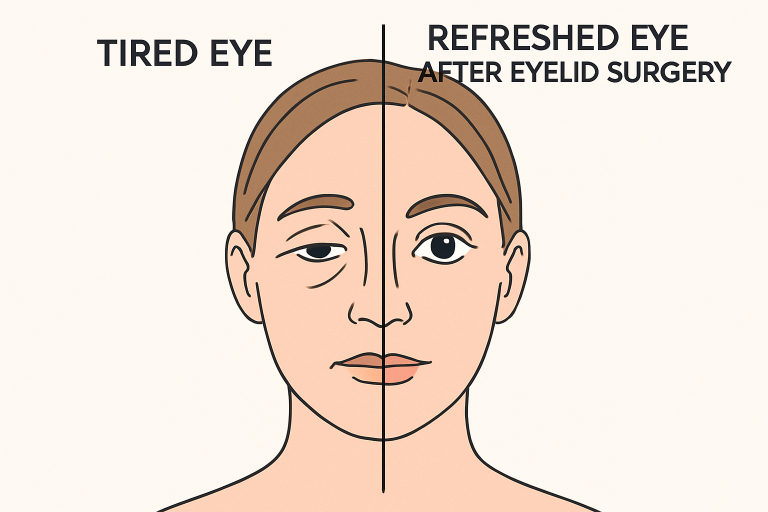Key Takeaways:
- Eyelid surgery, or blepharoplasty, is increasingly popular among younger individuals seeking both aesthetic and functional improvements.
- Advancements in surgical techniques have led to more natural-looking results with shorter recovery times.
- Societal influences, including social media and changing beauty standards, contribute to the rising demand for eyelid procedures.
The Rising Popularity of Eyelid Surgery
In recent years, eyelid lift has witnessed a remarkable rise in interest—not only among those seeking a more youthful appearance but also a younger demographic intent on enhancing their facial aesthetics. Historically, eyelid surgery, formally known as blepharoplasty, appealed predominantly to adults wishing to minimize the visible signs of aging. The procedure’s visibility in media, from YouTube vlogs to TikTok makeovers, has greatly expanded its appeal. Now, patients in their twenties or thirties often opt for it to achieve a refreshed, ‘wide-awake’ look. Online forums and peer discussions reinforce that eyelid surgery is mainstream and attainable. It’s driven not just by aging concerns but also by the desire for brighter, more alert eyes amid video calls and selfies. In high-definition screens, facial features are scrutinized, raising worries about puffy eyelids or heavy lids. The surgery can also address functional issues like impaired vision from drooping eyelid skin, with ophthalmologists sometimes recommending blepharoplasty for health reasons, combining aesthetic and health benefits. This blend of function and beauty fuels its growing popularity across ages.
Advancements in Surgical Techniques
Technological advancements have significantly improved blepharoplasty over the past decade, with minimally invasive techniques like laser-assisted eyelid lifts and transconjunctival methods reducing scarring and speeding up recovery time. These methods focus on small, discreet incisions and dissolvable sutures, resulting in less postoperative discomfort. Patients typically experience shorter downtime and return to normal activities sooner, with results that blend seamlessly with natural facial features. Innovations like platelet-rich plasma treatments and enhanced anesthesia protocols also contribute to reduced swelling and bruising. The focus on individualization allows surgeons to tailor each procedure to specific anatomical needs, improving overall outcomes and promoting a natural, rejuvenated look without appearing overdone or artificial.
Societal Influences and Changing Beauty Standards
The normalization of aesthetic enhancements is largely due to the influence of social media and pop culture. Idealized visuals, filtered selfies, and influencer-endorsed beauty standards have increased personal scrutiny of facial features. Social platforms encourage users to share before-and-after photos and testimonials, making procedures like blepharoplasty openly discussed and celebrated. High-profile celebrities and public figures have also destigmatized the practice, making blepharoplasty a familiar choice for those seeking subtle yet impactful changes. Broad societal acceptance has reduced barriers for first-time patients, and professional opportunities in beauty, fashion, and entertainment industries can drive individuals towards enhancement procedures. Consumer access to information about procedural safety, reviews, and transparent pricing has made the decision-making process less intimidating and more empowering.

Functional Benefits Beyond Aesthetics
Eyelid surgery, often praised for its rejuvenating effects, has a significant impact on functionality. Many people suffer from sagging eyelids that hinder vision, causing discomfort and reducing their daily quality of life. Blepharoplasty can alleviate this impairment, offering cosmetic enhancement and improved sight and comfort. This enhances activities like driving, reading, and sports, boosting well-being. The removal of excess skin reduces heaviness or eye fatigue, especially after prolonged screen time. Some patients experience life-changing improvements, enabling them to participate fully in social events, feel more confident at work, and pursue hobbies they once struggled with. The integration of cosmetic and medical outcomes sets eyelid surgery apart from other voluntary enhancement options. Surgeons collaborate with eye care professionals to ensure comprehensive preoperative assessments and maximize potential benefits.
Considerations for Potential Candidates
Eyelid surgery should be approached with the help of board-certified surgeons who can evaluate a candidate’s health, skin elasticity, and individual goals. The consultation phase is crucial for tailoring the procedure to meet unique needs. Surgeons assess a detailed health history, medication use, allergies, and prior ocular issues to avoid complications. Pre-surgical planning, clear communication, and realistic outcome assessments are essential for patient satisfaction and safety. While blepharoplasty offers cosmetic benefits, it cannot completely stop aging or solve facial issues. Healthline provides guidelines on eyelid surgery preparation, side effects, and aftercare routines. It is advised to avoid blood-thinning medications, adhere to pre-op fasting requirements, and have a trusted friend or family member assist during the surgery and recovery.
Post-Surgical Recovery and Care
Recovery from eyelid surgery is generally easy, with minimal discomfort and swelling. Post-operative care instructions include rest, avoiding strenuous activity, using prescribed ointments or eye drops, using cold compresses, keeping the head elevated, and maintaining proper hygiene. Regular follow-up appointments allow the surgeon to monitor healing progress and address any concerns. Most swelling and bruising subside within two weeks, and sutures are typically removed five to seven days post-operation. Aftercare is crucial for optimal results and a smooth return to daily routines. Patients usually notice the outcome after one to three months, as residual swelling resolves and scar tissue softens. Avoiding smoking, sun exposure, and wearing sunglasses supports long-term healing and protects delicate eye skin. Communication with the surgeon is essential for early detection of rare complications and peace of mind.
Long-Term Outcomes and Satisfaction
Eyelid surgery results in high satisfaction, with many individuals experiencing cosmetic improvements, self-image boosts, and increased confidence. These emotional benefits extend to social interactions and participation in public events. The longevity of the results depends on genetics, skin quality, and lifestyle factors. Maintaining a healthy lifestyle, including sun protection and proper skincare, can prolong the effects of the surgery. Most people enjoy lasting enhancements and are satisfied with their rejuvenated appearance for several years post-procedure. Advances in technique and post-surgical care continue to improve short- and long-term outcomes. Choosing an experienced surgeon and following proper aftercare ensures a rewarding and trouble-free outcome.
Conclusion
Eyelid surgery marks an important shift in how society perceives aging and approaches beauty. As both attitudes and technologies evolve, the procedure is better understood, increasingly accessible, and more refined. Its blend of cosmetic transformation and functional benefits makes it a compelling choice for a wide spectrum of patients, from young adults to mature individuals, seeking to put their best face forward with confidence and clarity. For many, blepharoplasty represents more than just a change in appearance—it’s a step toward broader well-being, self-assurance, and active engagement in all aspects of life.
The Editorial Team at Healthcare Business Today is made up of experienced healthcare writers and editors, led by managing editor Daniel Casciato, who has over 25 years of experience in healthcare journalism. Since 1998, our team has delivered trusted, high-quality health and wellness content across numerous platforms.
Disclaimer: The content on this site is for general informational purposes only and is not intended as medical, legal, or financial advice. No content published here should be construed as a substitute for professional advice, diagnosis, or treatment. Always consult with a qualified healthcare or legal professional regarding your specific needs.
See our full disclaimer for more details.







